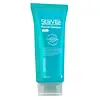What's inside
What's inside
 Key Ingredients
Key Ingredients

 Benefits
Benefits

 Concerns
Concerns

 Ingredients Side-by-side
Ingredients Side-by-side

Lauryl Glucoside
CleansingPanthenol
Skin ConditioningAllantoin
Skin ConditioningNiacinamide
SmoothingCocamide DEA
EmulsifyingLactic Acid
BufferingSalicylic Acid
MaskingSodium Chloride
MaskingAloe Barbadensis Extract
Skin ConditioningPhenoxyethanol
PreservativeGlycyrrhiza Glabra Root Extract
BleachingCocamidopropyl Betaine
CleansingCocamide Mea
EmulsifyingMelaleuca Alternifolia Leaf Oil
AntioxidantThymus Vulgaris Extract
PerfumingSalvia Officinalis Extract
AntimicrobialGlycolic Acid
BufferingAlgae Extract
EmollientCitric Acid
BufferingDisodium EDTA
Tocopheryl Acetate
AntioxidantCaffeine
Skin ConditioningBisabolol
MaskingZingiber Officinale Extract
Skin ConditioningSalix Nigra Bark Extract
Skin ProtectingWater
Skin ConditioningLauryl Glucoside, Panthenol, Allantoin, Niacinamide, Cocamide DEA, Lactic Acid, Salicylic Acid, Sodium Chloride, Aloe Barbadensis Extract, Phenoxyethanol, Glycyrrhiza Glabra Root Extract, Cocamidopropyl Betaine, Cocamide Mea, Melaleuca Alternifolia Leaf Oil, Thymus Vulgaris Extract, Salvia Officinalis Extract, Glycolic Acid, Algae Extract, Citric Acid, Disodium EDTA, Tocopheryl Acetate, Caffeine, Bisabolol, Zingiber Officinale Extract, Salix Nigra Bark Extract, Water
 Reviews
Reviews

Ingredients Explained
These ingredients are found in both products.
Ingredients higher up in an ingredient list are typically present in a larger amount.
Allantoin is a soothing ingredient known for its protective and moisturizingg properties. Because of this, it is often added to products with strong active ingredients.
Studies show higher concentrations of this ingredient can promote wound healing.
Though it can be derived from the comfrey plant, allantoin is produced synthetically for cosmetic products to ensure purity.
Learn more about AllantoinLauryl Glucoside sugar- and lipid-based cleansing agent. It is created from glucose and lauryl alcohol.
This ingredient is a surfactant, making it easier to rinse oil, dirt, and other pollutants away.
A British study found lauryl glucoside to cause skin sensitivity for some people. We recommend speaking with a professional if you have concerns.
Other names for this ingredient include "Lauryl Polyglucose", "Lauryl glycoside", and "D-Glucopyranoside".
Learn more about Lauryl GlucosideThis tea tree oil comes from the leaves of the Tea Tree plant. Tea tree oil has antioxidant, anti-inflammatory, and antimicrobial properties.
According to the book Journal of Profiles of Drug Substances, tea tree helps in reducing acne-causing bacteria such as Propionibacterium acnes. This is due to the Terpinen components of tea tree oil.
Tea tree may cause sensitivity and irritation for some people. This oil naturally contains fragrance such as linalool and limonene.
However, research shows irritation usually occurs when using pure tea tree oil and not in cosmetic products.
Tea tree oil was found to help relieve the symptoms of psoriasis in one study.
Tea tree oil is toxic when ingested. Another study showed it to caused damage to the nervous system of dogs and cats when applied to their skin or given orally.
Learn more about Melaleuca Alternifolia Leaf OilPanthenol is a common ingredient that helps hydrate and soothe the skin. It is found naturally in our skin and hair.
There are two forms of panthenol: D and L.
D-panthenol is also known as dexpanthenol. Most cosmetics use dexpanthenol or a mixture of D and L-panthenol.
Panthenol is famous due to its ability to go deeper into the skin's layers. Using this ingredient has numerous pros (and no cons):
Like hyaluronic acid, panthenol is a humectant. Humectants are able to bind and hold large amounts of water to keep skin hydrated.
This ingredient works well for wound healing. It works by increasing tissue in the wound and helps close open wounds.
Once oxidized, panthenol converts to pantothenic acid. Panthothenic acid is found in all living cells.
This ingredient is also referred to as pro-vitamin B5.
Learn more about PanthenolSalicylic Acid (also known as beta hydroxy acid or BHA) is a well-known ingredient for treating skin that struggles with acne and clogged pores. It exfoliates both the skin's surface and deep within the pores to help clear out buildup, control oil, and reduce inflammation.
Unlike AHAs (alpha hydroxy acids), salicylic acid is oil-soluble. This allows it to penetrate into pores which makes it especially effective for treating blackheads and preventing future breakouts.
Salicylic acid is also known for its soothing properties. It has a similar structure to aspirin and can calm inflamed or irritated skin, making it a good option for acne-prone skin that is also sensitive.
Concentrations of 0.5-2% are recognized by the U.S. FDA as an over-the-counter topical acne product.
It can cause irritation and/or dryness if one's skin already has a compromised moisture barrier, so it's best to focus on repairing that before introducing this ingredient into your routine.
While salicylic acid does not increase sun sensitivity, it’s still important to wear sunscreen daily to protect your skin.
If you are looking for the ingredient called BHA or Butylated Hydroxyanisole, click here.
Learn more about Salicylic Acid